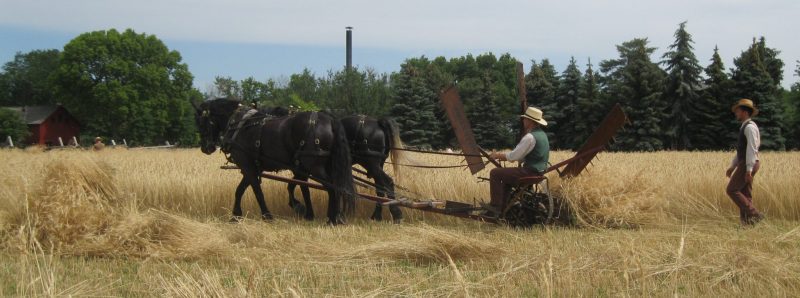Agriculture and public history: A working group
13 April 2018 – Debra Reid
It’s an exciting time for public historians interested in putting the farm-to-fork movement into historic context. Recent books, including Interpreting Food at Museums and Historic Sites (2015), Interpreting Agriculture at Museums and Historic Sites (2017), and Public History and the Food Movement: Adding the Missing Ingredient (2018), demonstrate that public historians are bringing new insights to bear on interpreting agricultural history and food history.

Reaping wheat at Firestone Farm in Greenfield Village, Dearborn, Michigan, July 6, 2017. Photo credit: Debra A. Reid
In contemporary society, agriculture, an essential human activity, has gained a reputation as a destroyer of ecosystems and genetic diversity. Alternative agriculture serves as agriculture’s alter ego—the approach associated with organic producers or farmers committed to using oxen or horses rather than fossil fuels. Agriculture is more complicated than this duality conveys. Both alternative and industrial farm families, and consumers, function between these two extremes. Increasing public engagement with agriculture can sustain engagement with a subject essential for human survival.
Public history can draw attention to the sustainable models that existed historically and that remain worthy of preserving, interpreting, and perpetuating. This task requires analysis of site-specific evidence that documents local food, fuel, and fiber production and marketing systems that co-existed with global commodity chains. Today, local food systems are experiencing a rebirth, and that is reason enough to draw more attention to the issues via public history.
Support systems exist for those interested in putting farm-to-fork and slow-food initiatives into historic context. The second oldest professional history organization in the United States, the Agricultural History Society (AHS), began in 1919. The AHS attracted an interdisciplinary group of historians, some in academia but others in civil service positions. The history that they studied, be it agricultural production, marketing, land policy, and technology, had direct application to their work. It informed public policy as well as museum curation of collections at the Smithsonian Institution, the International Harvester collection, and the Museum of Science and Industry in Chicago, to name a few.
The Association for Living History, Farm and Agricultural Museums (ALHFAM) began in 1970. ALHFAM provides resources to interpret agriculture, facilitates the exchange of information via professional interest groups, and offers regional and international conferences and skills workshops. Members can access ALHFAM’s Skills and Knowledge Base, featuring nearly 25,000 items (nearly 50 years’ worth) of ALHFAM publications about the theory and practice of agricultural interpretation and living history programming.
Interpreting agriculture serves a public good if it fosters public discourse. This is a tall order given the general lack of understanding about agricultural practices and associated policy, economics, and social and cultural systems, historically and today. To advance this goal of fostering productive discourse on agriculture and food history, the “Agriculture and Public History” working group at the 2018 NCPH annual meeting will:
- Devise strategies that can make historic sites and public history projects a “go-to” source to increase agricultural literacy (delivering content about local food systems as well as global commodity chains of food, fuel, and fiber).
- Adopt a humanist perspective and develop humanities-based strategies to engage the public in agriculture and agricultural history. Note that humanities disciplines (history, art, theater, philosophy, literature) and social sciences disciplines (politics, culture, economics, cultural geography) can inform public interpretation of agriculture (a theme naturally related to STEM disciplines).
- Devise and test approaches to document agriculture and the environment in specific places/regions, within crop and livestock cultures; and show how place/environment affected crop and stock management and human relationships over time. Note that this local research will document changes in local food systems over time, will document production and processing of feed for humans, feed for animals, and feed for both, and will indicate relationships between local food systems and global commodity chains.
- Develop a framework for museums, historical societies, and historic sites (including living history farms) to use in collection and interpretive plan development.
- Ensure that gender, race, ethnicity, power, and authority inform all projects.
- Ensure that historic connections, rather than rural-urban dichotomies and myths, inform all projects.
Conference attendees are invited to join the conversation and share their perspectives on how public historians can continue to foster public discourse on the past, present, and future of agriculture and food.
~ Debra A. Reid is curator of agriculture and the environment at The Henry Ford, Dearborn, Michigan, and author of Interpreting Agriculture at Museums and Historic Sites (2017). You can reach Reid at [email protected]



